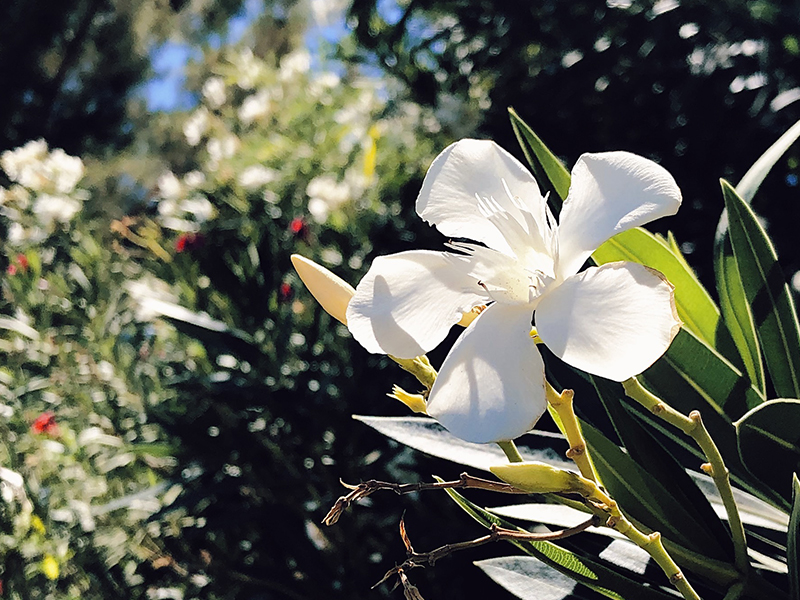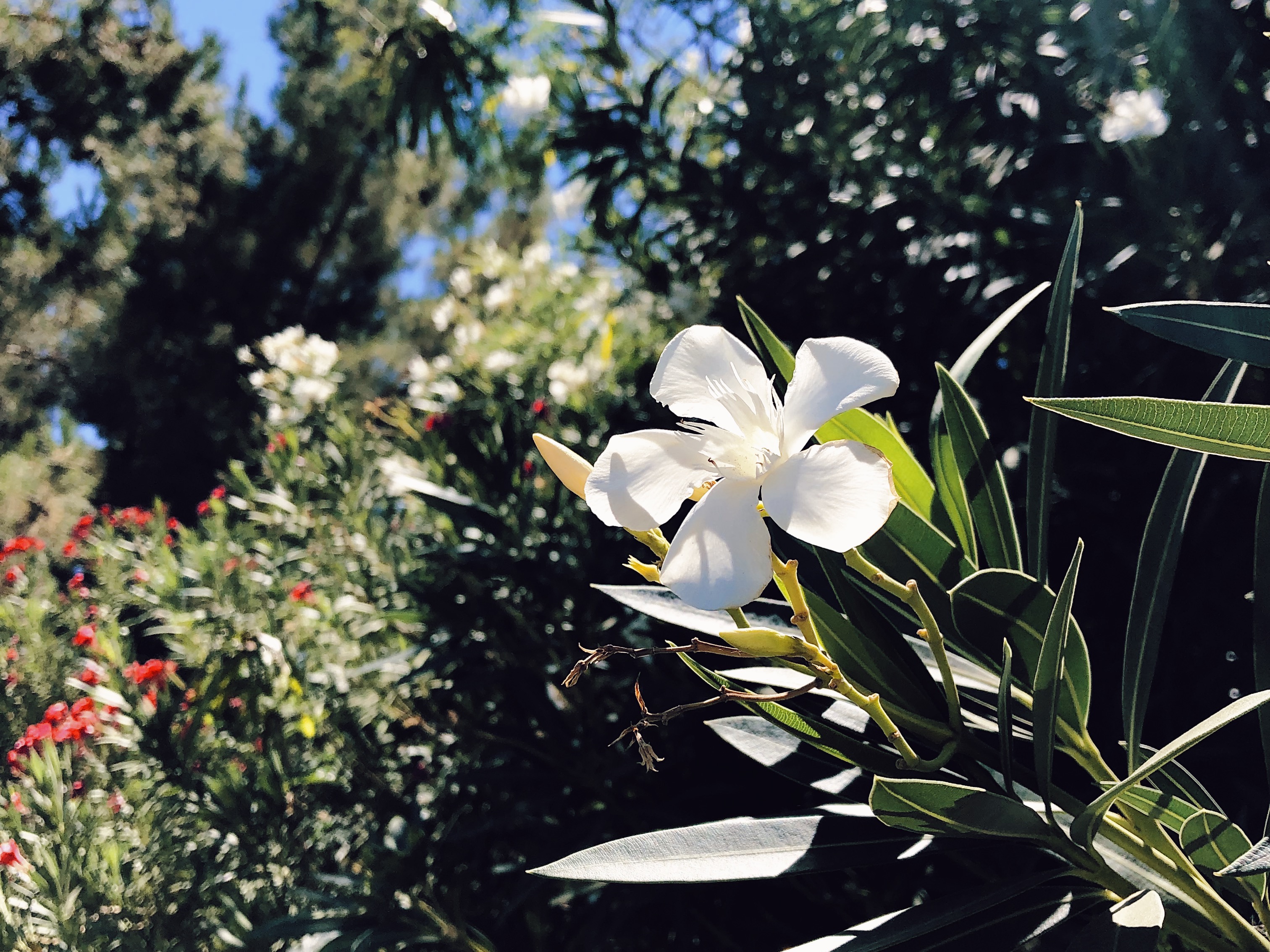Join the July EcoQuest: Oleander Occurance
This month’s EcoQuest is in collaboration with Strategic Habitat Enhancements (SHE).
Strategic Habitat Enhancements empowers the community to reconnect with nature through resilient desert gardening, creating an urban network of wildlife and pollinator habitat. Founder Carrianne Campbell has worked as an environmental consultant across the southwest, learning more and more with every new project, and unraveling the secrets of the native plants that make this region so unique. Two years ago, she decided to build a business that creates accessible and educational options for home owners, and this is how SHE came to be.
Be sure to follow SHE on social @strategic_habitats
Introduced to the Americas and believed to have their origin in the Mediterranean region, oleanders are a familiar sight to many residents in the United States. The International Oleander Society claims the plants first arrived in Galveston, Texas in 1841. It is said that a sailing merchant brought them from Jamaica as a gift to his wife and sister-in-law. Easy to cultivate and fast-growing, the plants were passed to neighbors and friends and can now be found growing across the entirety of the warmer southern United States.
Metro Phoenix is also no stranger to oleanders. Many websites, organizations, nurseries and even government agencies have long recommended oleanders for planting. They are fast growing, sun loving, drought, poor soil and salt tolerant, and can create dense privacy screens. They bloom profusely with brightly colored and aromatic flowers. Oleanders are well-suited for our desert environment and have even become naturalized in some areas, but there’s more to know about these hardy shrubs.
When it comes to pollinators, oleanders have a trick up their sleeve. The flowers of this plant are specifically adapted with a tactic known as deceit pollination. Most plants “reward” pollinators with nectar for visiting and pollinating flowers. The pollinator gets energy from the nectar while the plant receives the benefit of being pollinated. Oleanders, however, lure pollinators in with a sweet smell and showy flowers, but there is no nectar to be found. Pollinators burn precious energy while pollinating oleanders, with no reward for their work.
In addition, oleander seeds are dispersed by wind, making it easier for the plants to spread into new areas. The Bureau of Land Management and the US Forest Service include this plant on the Arizona Priority Noxious and Invasive Plant List for their 2021 Annual Maintenance Plan. This plan is in coordination with the Arizona Department of Transportation (ADOT) and the Federal Highway Administration (FWHA) to manage invasive plants along roadways that can affect nearby public lands. The Tonto National Forest acknowledges oleander’s invasive potential, with naturalized populations being found in Telegraph Canyon and Camp Creek. Saguaro National Park has also found populations within the park boundary.
Oleanders are also considered toxic, with every part of the plant containing 10 different cardiac glycosides, which can induce cardiac arrhythmia and eventually death. It is also toxic to livestock and grazing animals, so live plants, cuttings or pruned parts should never be dumped anywhere where those animals might be able to access them. Inhaling smoke from oleanders can also cause poisoning. These plants are also susceptible to oleander leaf scorch, which has no cure and is spreading in Arizona. This is caused by sap-feeding insects spreading the Xylella fastidiosa bacteria. Water and nutrient uptake are disrupted and the plants eventually lose all of their leaves and can no longer survive.
When thinking about urban ecosystems, it’s important to consider which plants we choose to plant and where. Oleanders are widely planted in metro Phoenix. How much habitat are these plants potentially occupying and could other plants that are better suited and more beneficial for pollinators be planted instead?
Observations from this EcoQuest can contribute population and occurrence data for oleander in metro Phoenix. We can learn more about how this plant may be taking up valuable habitat area that could otherwise be used to better benefit pollinators, ecosystems and people.
WHAT TO OBSERVE:
Oleander, Nerium, rose laurel
Nerium oleander
Apocynaceae (Dogbane Family)
Mediterranean Region
Form & Character: Oleander is a versatile evergreen shrub, stiff low, rounded and mounding to strongly upright and open, often imposing.
Leaves: Simple, opposite or whorled in 3 4, elliptical, smooth margin, 10 in. long, 1 in. wide.
Flowers: Varied, white, pink, purple, showy, clusters at the end of branches, April–September.
PLEASE observe COVID-19 guidelines/recommendations.
This a great opportunity to get outdoors close to home as we all navigate the complications of COVID-19. However, it is imperative that you follow the guidelines/recommendations of your local governments and institutions (wear a mask, practice physical distancing and wash your hands). Do what’s best for you and your community.
Arizona Office of Tourism: Responsible Recreation in AZ
https://tourism.az.gov/responsible-recreation-across-arizona
Please do not observe indoor houseplants or pets.
For your own safety and the protection of plants and wildlife, do not trespass when making observations. Please follow all posted rules and guidelines in parks/preserves and do not enter private property.
Do not remove or move natural materials (plants, animals, rocks).
Respect wildlife (do not touch, feed, or disturb animals and keep a safe distance).




